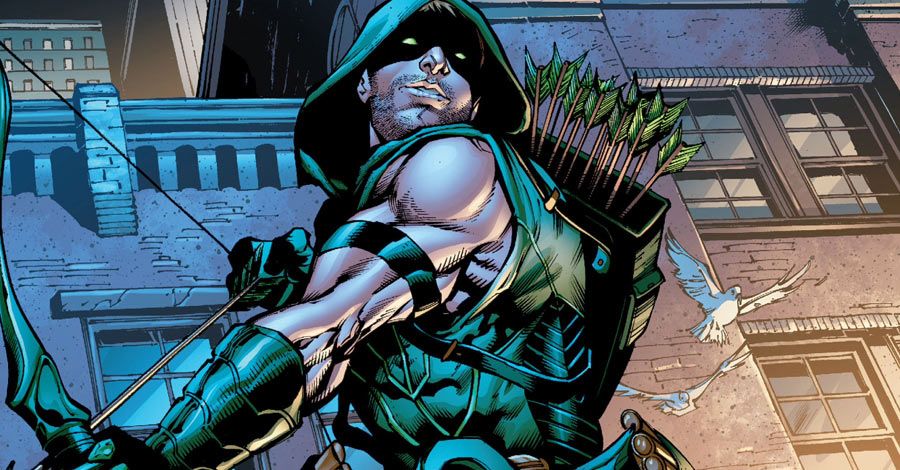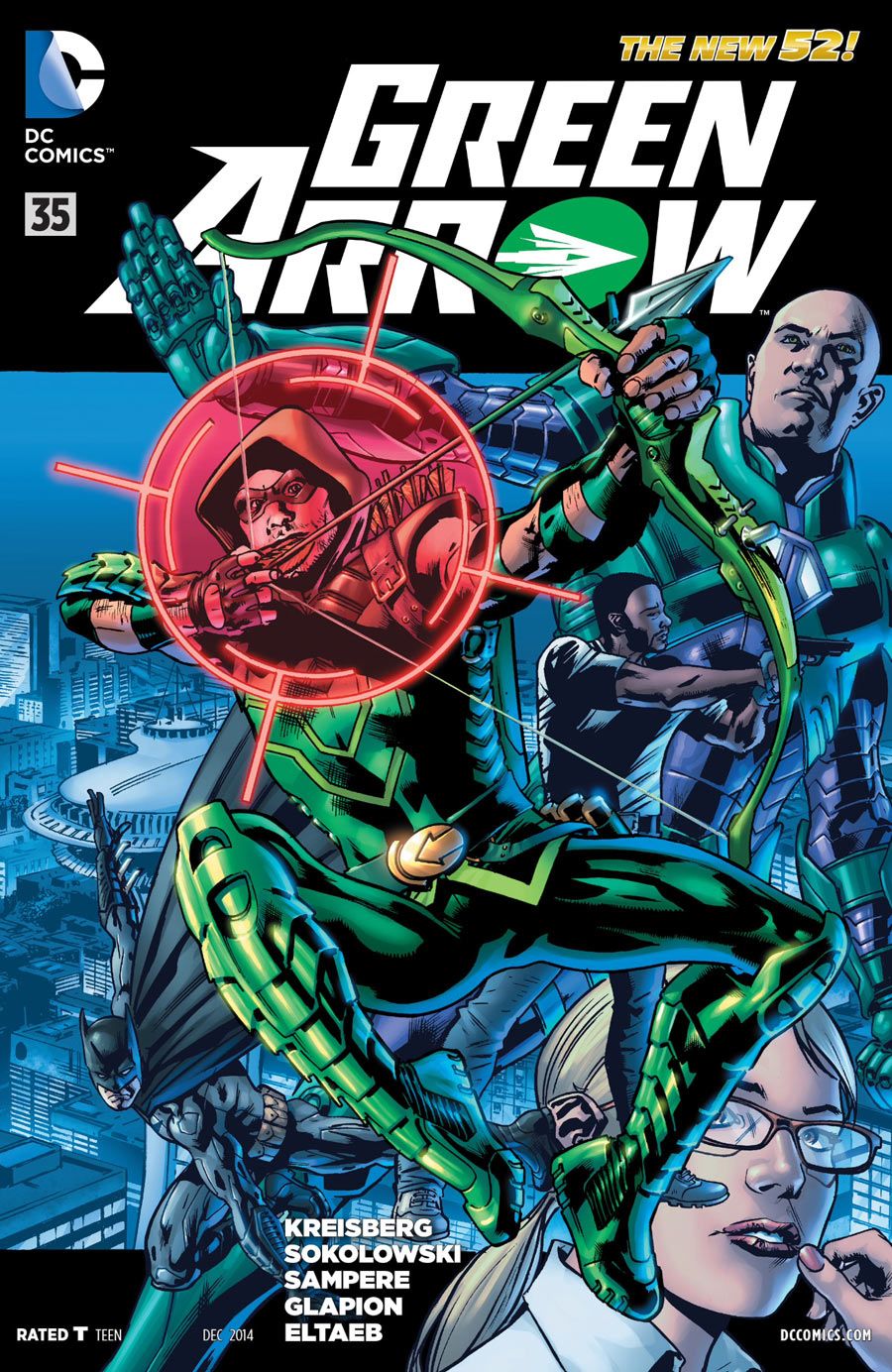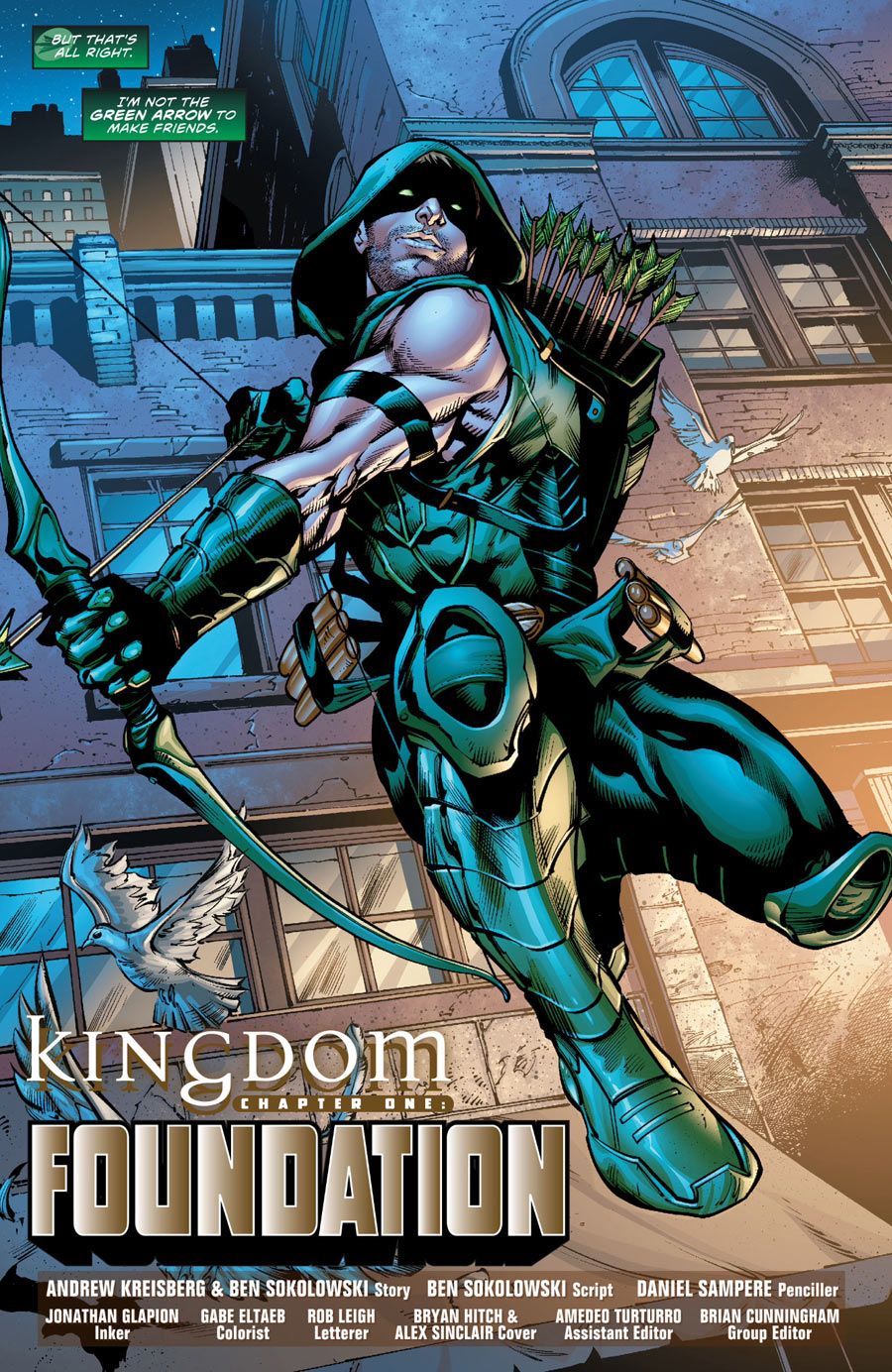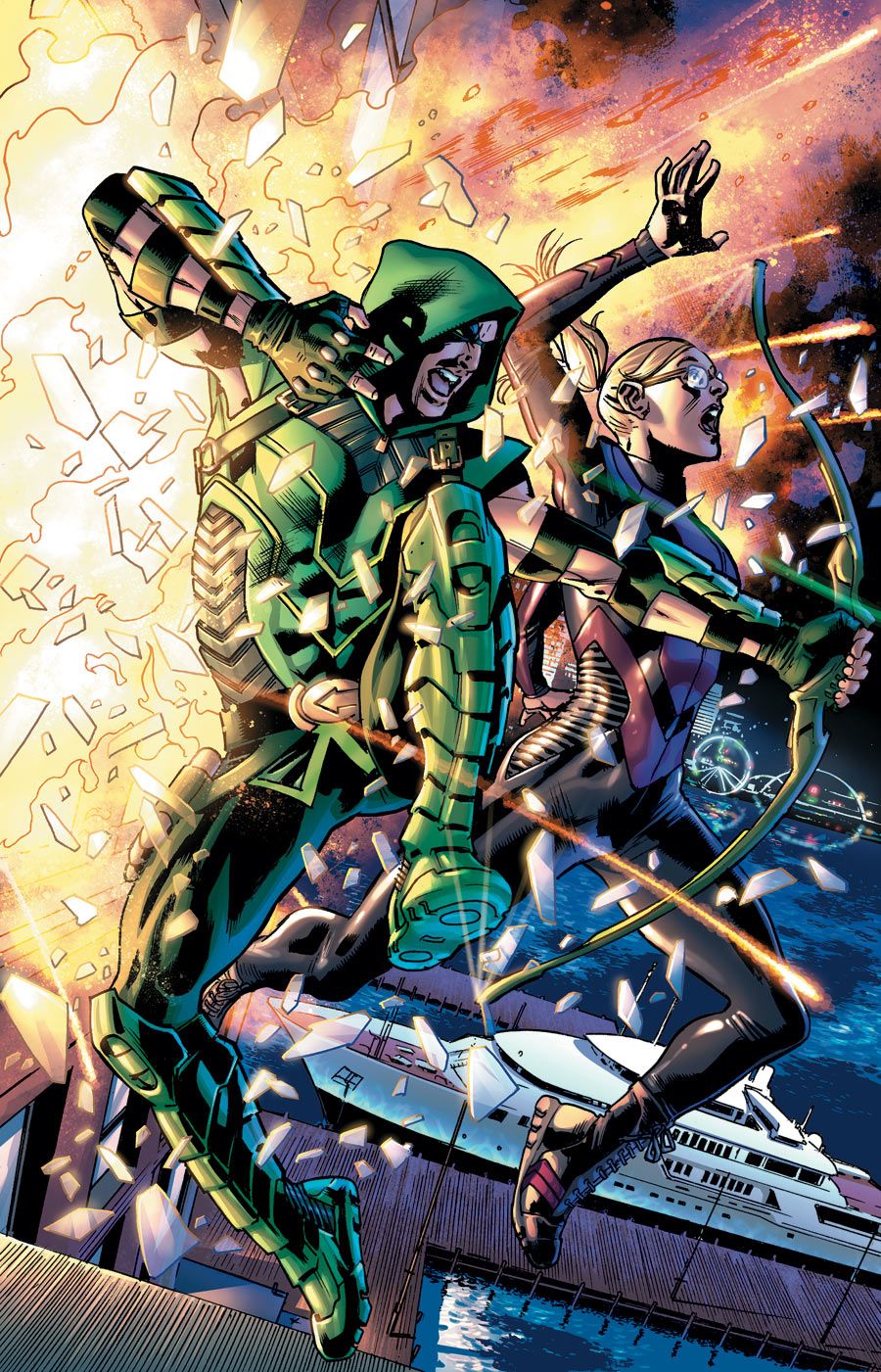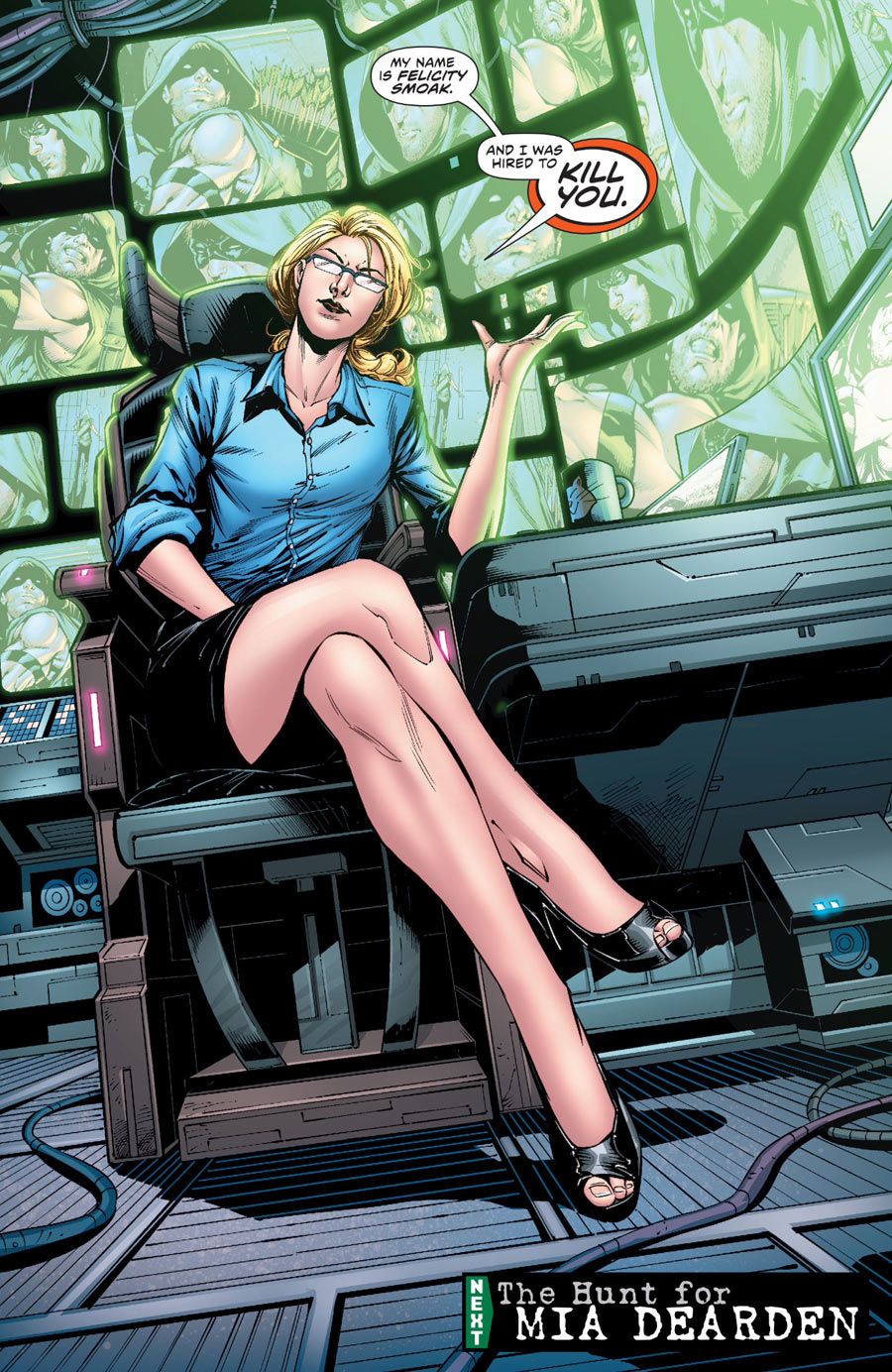[SPOILER ALERT: This article contains spoilers for "Green Arrow" #35, on sale now.]
Felicity Smoak -- one of the most beloved characters on The CW's DC Comics-based TV series "Arrow" -- has arrived in the DC Universe. Fittingly, she's being introduced into the broader world of DC's comic book continuity by new "Green Arrow" co-writers Andrew Kreisberg and Ben Sokolowski -- Kreisberg is an executive producer and showrunner on both "Arrow" and the soon-to-debut "The Flash," and Sokolowski is a staff writer on "Arrow."
Yes, "Felicity Smoak" has been in comic books before, as a "Firestorm" character in the mid-'80s. But the character played on "Arrow" by Emily Bett Rickards is a very different one, and the basis of the character that debuts in the last page of this week's "Green Arrow" #35 -- Kreisberg and Sokolowski's first issue of the series. The fact that Felicity is in the comic isn't a shock -- Kreisberg openly discussed her debut just a few weeks ago -- but her opening line is: "My name is Felicity Smoak. And I was hired to kill you." That's not exactly what you'd expect to hear from a character known as one of Oliver's closest allies, with more set to unfurl as the story guided by Kreisberg, Sokolowski and the art team of Daniel Sampere, Jonathan Glapion and Gabe Eltaeb progresses.
With a week before next Wednesday's third season premiere of "Arrow" and "Green Arrow" #35 fresh on the physical and digital stands, CBR News caught up with the Kreisberg and Sokolowski before a singing this week at Meltdown Comics in Hollywood, to talk Felicity's comic book debut, "melding" the worlds of comics and "Arrow," getting to do things not possible on TV and the new villain set to plague Oliver Queen and bring new life to Green Arrow's rogues gallery.
CBR News: Andrew, Ben, you're both obviously busy people -- Ben, you're a writer on "Arrow" and Andrew, you're currently co-running two shows, both "Arrow" and "The Flash" -- at what point did you decide, 'Hey, let's add a monthly comic to that schedule'?
Andrew Kreisberg: I think the thing that helps is that we're doing it together. As much as we love the "Green Arrow" comic, and we certainly enjoyed Jeff Lemire's run on it, once he announced that he was deciding to leave, we just thought there was an opportunity to do something slightly different with the book -- which was to meld the two worlds of the comic book Oliver Queen and the TV show Oliver Queen, and take some of the more successful characters from the TV show and introduce them in the comic, and then have them get mixed up with the characters who are already in the comic book.
It's sort of this brand-new thing that's this amalgamation of every different aspect of Green Arrow. Hopefully, that way there's a little but something for everyone. For the people who watch the TV show and have never checked out the comic, maybe seeing Dig [John Diggle] and Felicity in it would bring them across, and for the people who have been enjoying the comic and maybe never checked out the show, they'll get to see what is special and fun about some of those characters.
Andrew, you've had a good amount of prior comic book writing experience, but Ben, you've worked on the digital "Arrow" tie-in comic, but this is you first work in the larger DC Universe -- how are you enjoying diving into that world?
Ben Sokolowski: To have the opportunity to write not only Oliver Queen, but Bruce Wayne and Lex Luthor, within 10 pages of my first DC Universe book -- that was a bit of a jaw-dropping experience. It's just an honor to be added to the long list of writers to work with those characters, and the mythology and the universe. It's probably one of the biggest thrills of my career.
Ben, how has the transition to comic book writing been for you? You hear both extremes -- sometimes people say there is a big adjustment in going from writing TV or movies to comics, and some say it's a fairly similar experience. How has it been for you?
Sokolowski: I think the "Arrow" tie-in digital comic was really the training route, in a sense. Not that I was making mistakes there, but that's what enabled me to jump into this book -- the confidence of knowing, "Yeah, I can write a comic book. It is different than writing a TV script, but I know how to do it, and I think I can do it pretty well. Especially with Andrew's guidance. It's been a pretty easy transition.
For both of you -- you're bringing things a little closer to the TV show with this run, but how much of the fun of what you're doing is bringing in characters like, as seen in #35, Bruce Wayne and Lex Luthor -- things you can't do on the show?
Kreisberg: That's the biggest fun. Ben and I write Dig and Felicity every single day, but to get to have Dig and Felicity in the same comic book with Bruce Wayne and Lex Luthor, and some of the other fairly exciting big-name guest stars that we've got coming up in the book...
We're very happy with the "Arrow"-verse that we get to play in on TV -- between Oliver and the Atom and the Flash and the Huntress and Katana -- but there are certain characters that are outside of our purview in TV, but we get to play with them in comic books. That's incredibly exciting.
There's also the scale of it -- "Arrow" has gotten pretty darn big in its first two seasons, but there are still practical restrictions of live-action TV that aren't there in a comic, in terms of what you can do, what you can show, and the type of pyrotechnics you can have. Is that also a big part of what you're exploring here?
Kreisberg: Absolutely. We have a few sequences -- the sequence on the bridge is insane. We are constantly amazed at what we're able to pull off on the TV show. We always write what we call "the Cadillac version" -- sometimes they literally pull off exactly what we wrote, and that at other times it gets scaled down. But the Cadillac version of the comic book is a better model, pricier Cadillac with all of the fixins.
It's funny -- even when we're doing the tie-in books, whether it's the "Arrow" book or "Flash," there's sometimes been this tendency to think of it like the TV show, and not think big enough. It's having to remind people, "No, no, this is a comic. Oliver can jump out of a helicopter."
Sokolowski: We literally have a budget of a billion dollars.
Kreisberg: Getting to see that stuff is definitely part of the fun. We have a sequence coming up in a few books where you get to see Felicity involved in an action sequence the likes of which she has never and probably will never be [involved in] on the TV show.
In the "Green Arrow" comic book, it's not exactly the same Oliver Queen as on the TV show, but it's certainly closer than the older, goateed version from the pre-New 52 DC Universe. How close do you see the two characters at this point? And what kind of distinctions do you make between them?
Kreisberg: We actually look at more of the differences than we do the similarities. Obviously he's Oliver Queen, billionaire, was marooned and came back with a mission. It's funny, because the Oliver in the comic book is slightly younger than the Oliver on the TV show played by Stephen Amell, and yet the comic book Oliver feels more emotionally mature than our TV show version. Our sort of overall arc of the series is about a man who lost his humanity, and how he's finding it again. I think that the Oliver Queen in the comic book, certainly right now and even before The New 52, was somebody who was a little bit more in touch with his feelings; a little bit happier person who enjoyed what he was doing a little bit more, and wasn't quite so angst-ridden as he is on the TV show.
For me, that's actually what makes it fun -- that we're not writing the same character, necessarily. He is the same character, but just as there's so many different iterations and versions of Batman or Superman, we're writing a slightly different iteration. And since we have a slightly different iteration of Felicity and Dig, all of their interactions are new and different. Just like if you're picking up a Batman comic from the '70s or the '80s or the '90s, the way Bruce and Alfred, or the way that Bruce and Dick Grayson relate to each other, is always different from era to era and book to book and artist to artist. The Green Arrow that we're doing now is not an adaptation of the TV show -- it's a brand-new take on the character where alchemy has occurred between all the different versions that have existed before it.
Personality-wise, this Oliver feels a little more settled down.
Sokolowski: I think he's found the humanity that the TV Oliver is still searching for.
Obviously, we need to talk about Felicity -- was introducing her to the comics always one of the main things you wanted to do as you were coming on board the series?
Kreisberg: Yeah. We were so honored when Jeff Lemire added Dig to his run. I don't think anyone was prouder than David Ramsey himself. He was just so amazed. There have been a few instances where you have a character who is created for a different medium who then went backwards into the comics -- the big one I think of is Harley [Quinn], who was created for ["Batman: The Animated Series"], and now you can't imagine the DC Universe without her.
Yes, Felicity was a very minor Firestorm character -- we really took that name, and Emily Bett Rickards have entirely given her life. We've always sort of joked how great it would be if she suddenly found her way into the comics. Her and Dig, because we're so proud of those characters, and they feel like such a great extension of Oliver Queen, that they've gone back into the comics, and if they become mainstays -- I think the proudest thing we would feel is if the next artists of writers who pick up the book say, "You know what, 'Green Arrow' really feels right if John Diggle is his bodyguard, and Felicity Smoak is his right-hand woman." And having that page be, "Hi, I'm Felicity Smoak, I was hired to kill you" -- we had that idea before we even knew what anything else was about.
In terms of how you approach the character, do you see Felicity as pretty similar to the TV version, but again, there are some important differences that are at work here?
Sokolowski: I think it's another case of similar but different. With Felicity, she isn't the Felicity we know and love on the TV show -- at heart she is -- but maybe she's been doing this for a lot longer, and she has maybe a slightly different backstory where she comes from a different side of the good vs. evil fight -- not to give anything away. She's bringing something new to the table [other than] a straight-up adaptation.
Kreisberg: In TV, everybody being a little bit more emotionally damaged and not nearly in touch with their feelings make for great drama, because you can have those long scenes where people aren't quite sure what to say to each other. In comic books, people by definition have to actually say things to each other, because you have to write it down. [Laughs]
I think that the Felicity that we meet, just like Oliver, is a little bit more in touch with her feelings. She's not quite so shy. She doesn't get quite as mentally flustered as she does, especially around Oliver. But I think the affection that they have for each other, and the banter that they get into on the TV show when the TV show is really clicking, is something that you'll see in the comic books.
If you're a fan of Felicity, she's in there. We sort of said, it's like Felicity a few years on. Just in the same way that Felicity in Season Three of "Arrow" is not quite the same Felicity you saw, imagine her in a few more years when she's got a little more experience under her belt. We're excited about it.
You mentioned that you're bringing elements from the TV show into the comic -- #35 has a very big one in Felicity -- does that mean there is even more of that readers should look forward to, in terms of one bleeding to another?
Sokolowski: Potentially. I think right now our plan is really to explore the DC Universe, and of course, introduce a new villain that we're really excited about, and fans are going to love, and can hopefully be a part of the Green Arrow lore for a long time. It's a totally new character, and you get a glimpse of him in issue #35 -- you'll get to know him more, and love/hate him more as the arc continues.
Kreisberg: One of the toughest things we've found in creating the TV show is that Green Arrow does not have the world's best rogues gallery. It sort of starts at Merlyn and stops at Count Vertigo, and after that you're kind of on your own. One of the things we were really interested in doing is giving him a true nemesis that can hopefully last, and we've given him enough of a life and a background and enough of a tie to the main characters that hopefully that'll be something that can create a new framework for the book.
"Green Arrow" #35, Andrew Kreisberg and Ben Sokolowski's first issue of the series, is on sale now.

